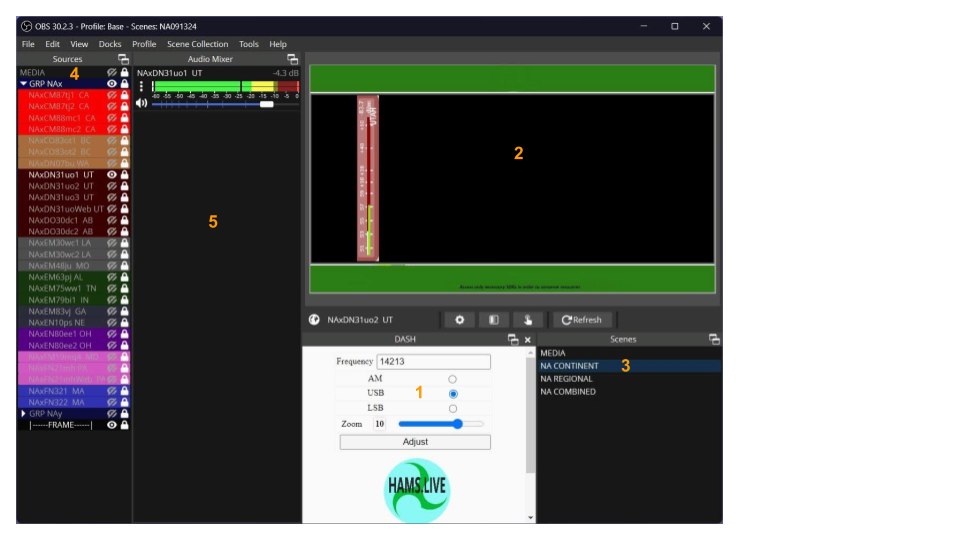After successful installation of OBS and all other installation steps, the
following provides basic information needed to use the hams.live system
BASIC ELEMENTS LAYOUT IN OBS

1 hams.live DASHboard
The DASHboard controls basic SDR parameters. In the Frequency field, type desired frequency IN KILOHERTZ with no spaces. Select the desired mode by clicking a radio button next to AM, USB, or LSB. If desired, adjust the SDR waterfall zoom level. Then, click the ADJUST button. There will be no visual indication, but after doing this all SDRs loaded into an OBS Scene Collection will be updated with this information. After activating one or more SDRs, changing any of the DASHboard parameters and clicking ADJUST will cause the SDR(s) to refresh with new parameters.
2 Canvas
The Canvas area in OBS is where visual rendering of SDRs will be displayed. As each SDR is activated, the S-meter portion will be shown. SDRs are color coded, matching colors shown in the SDR Sources List. These colors represent the relative position where SDRs are displayed in the Canvas within each Source Group. Right-clicking in the Canvas area will bring up a menu where options can be invoked to turn off the Canvas (uncheck Enable Preview) and alternatively display the Canvas in a separate window ( Windowed Projector Preview).
For those wishing to develop their own custom Scenes, OBS also allows for Source content in the Canvas to be moved and re-sized. This can be done by unlocking the Source (padlock icon shown to the far right in SDR Sources List). If the Source is in a Group, then the Group padlock would also need to to be unlocked. After this, when the Source is selected, bars will appear around the display in the Canvas which can be manipulated using the mouse.
3 Scenes List
The Scenes List controls which set of SDRs within a selected OBS Scene Collection are loaded into the SDR Sources List. The Scene name describes what purpose that the Scene provides (e.g., CONTINENT for wide coverage across a continent, REGIONAL for local coverage). Select a Scene based on what geographic assortment of SDRs is desired. Users can also create their own custom Scenes in a Scene Collection by selecting which SDRs are desired.
4 SDR Sources List
The SDR Sources List is the place where SDRs loaded from a Scene in an OBS Scene Collection are listed. Each SDR is sorted in the list alphabetically by Grid Square. SDRs are usually shown under a Group with each name indented. SDRs can be activated using the button to the right of each SDR name. Activated SDRs under a Group will not activate unless the button to the right of the Group name is also activated. This allows for several SDRs within a Group to easily be toggled on/off or refreshed with a single click. Within each Group, SDRs are color coded matching their S-meter and corresponding to where they display on the Canvas. In order to avoid display overlap, only one SDR with a given color code under each Group should be activated at a time.
An SDR Source that is activated can be selected in the List, and then select right-click-Interact. This brings a up a window showing the full SDR screen which can mostly be used like a web browser SDR session. Viewing SDRs in Interact mode can also be a way to determine if live streaming is actually taking place, or to select camp and/or queue when all SDR slots are occupied.
5 Audio Mixer
The Audio Mixer is where audio for activated SDRs can be controlled. As one or more SDRs are activated in the SDR Sources List, a slider control for each one will appear in the Audio Mixer along with the SDR name. SDR slider controls will be displayed in alphabetical order. Each slider control has a mute button, and when an SDR activates it should come up muted by default. However, if an SDR is unmuted and then de-activated in the SDR Sources List, OBS will remember the last state that the mute toggle was left in. When un-muting an SDR, the slider control will change from grey to color, and sound from the SDR should be heard coming from your default OBS monitoring device (OBS main menu/File/Settings/Audio/Advanced/Monitoring Device).